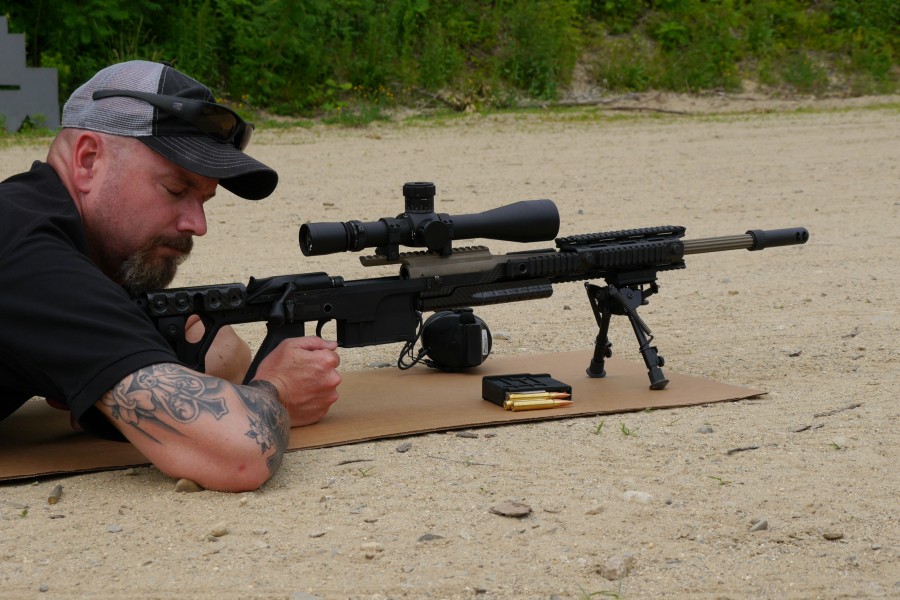RUAG is a new player to the ammunition game. Well, relatively speaking at least. Founded in 1998, the company has positioned itself as a high-quality ammunition manufacturer and a direct competitor to the likes of Hornady in the United States and Lapua over in Finland. That high quality positioning comes with a high quality price, but my only question is whether their ammunition matches up with their claims. To that end, RUAG sent us some of their 300 Winchester Magnum rounds to test and figure that out for ourselves . . .
Ammunition testing is a tricky business. Shooting groups and measuring the difference between the spread of the various calibers might seem like the most intuitive way to go, but there are way too many variables to produce a relevant result. In my opinion, the most accurate measurement of the relative consistency of ammunition is the interquartile range (IQR) of the observed velocity from a number of rounds from a single box of ammunition. The IQR of the velocities will give you an idea of how consistent the ammunition will group vertically, and the rest is up to the specific gun.
In this case, SIG SAUER was nice enough to provide one of their rifles for the testing. We shot a number of rounds through a chronograph, recorded the results, and ran them through my favorite statistical program (R). Here’s the summary of the raw results:
Min. :2927
1st Qu.:2933
Median :2935
Mean :2939
3rd Qu.:2946
Max. :2955
That puts the IQR for this caliber from RUAG at 13. In other words, 50% of the rounds flew within 13 feet per second of each other. To give you an idea of how that stacks up, we can look at the last set of tests we ran. The very best .308 ammunition I ever tested came in at 14. The very best 5.56 ammunition was 9. As far as I’m concerned, RUAG’s ammunition looks like it’s in the sweet spot in terms of accuracy. Nevertheless, I will always keep complaining until that range shrinks to zero.
What’s really remarkable is the extreme spread. The lowest and highest observations were only 32 feet per second different — Wilson Combat’s hand-loaded ammunition didn’t even reach that level of consistency.
The problem is that this is the first 300 Win Mag ammo we’ve tested, so we aren’t necessarily comparing apples to apples here. However, using my experience looking at the data and the previous results I can definitely say that this is some good stuff. To get a better idea of how RUAG stacks up I’ve asked for some of their .308 and 5.56 ammo, so stay tuned for an update. But in the meantime, this is definitely among the most consistent ammunition I have ever tested.





Bullet weight? Those numbers seem kind of slow…
honest question: why does the ammo need to be sooooo accurate does it really matter even at extreme range?
At the extreme distances is where it matters the most. Where the little changes become exponential.
Honest answer: for most of us it doesn’t, most likely.
However, it does say a lot about the quality of the processes used to make the ammo. Those numbers indicate they’re doing a good job of keeping powder quantity, bullet weight, etc, consistent. That doesn’t promise, but sure implies, some things about the care they take in the rest of the manufacturing process.
While I might not be able to make full use of the accuracy, I like knowing something will perform the same way every time I go to use it. And that’s essential during that 1% of the time when it *has* to work.
There’s still a lot to be said about just putting the ammo in a gun shooting groups. ‘Cause that exactly what’s going to happen anyways. IQR is great, but it doesn’t measure bullet concentricity, seating depth, etc.
Not a loading whiz by any stretch of the imagination, but 2 things…
Specifically: bullet depth WOULD be reflected in chrono results due to the change in case pressure, wouldn’t it?
Generally: Accuracy is simply a manifestation of consistency (trigger manipulation, sight placement/alignment, powder load, bullet weight, etc…) So a more consistent velocity would demonstrate scientifically and reliably the accuracy of a round as it takes out almost all shooter controlled variables. Specifically for vertical grouping (as mentioned), and horizontal grouping issues are almost always shooter and equipment related, no?
Typically one of the goals in load development is to adjust the COAL until the bullet is .0002″ or so from the lands. Consistency of cartridge length is a tiny measurement that is a big deal, and is one of many links in the accuracy chain. Although seating depth does affect pressure, so also does powder type, case capacity, amount of powder used, etc. Of course the gun and optic used brings in a host of other factors, as does the shooter, the range of the shots, and the environment in which the shots are taken.
Nick’s an IQR guy, and I respect that to an extent, but accuracy in ammunition is about more than just velocity. He’s explained his position, and I appreciate it. My position to test ammo would also be to test velocity, but to shoot the ammo for groups out of various premium platforms and optics. That is much more easily said than done, however.
Cool, .300 Win Mag. Don’t hear too much about it compared to .308 or .30-06.
You need to compare it to other brands before making a judgement. How do you know it is any better than say Federal Fusion? I also agree with accur81, you need to shoot it under realistic conditions to gage its accuracy.
Nick,
What are you guys using for a chronograph?
Comments are closed.